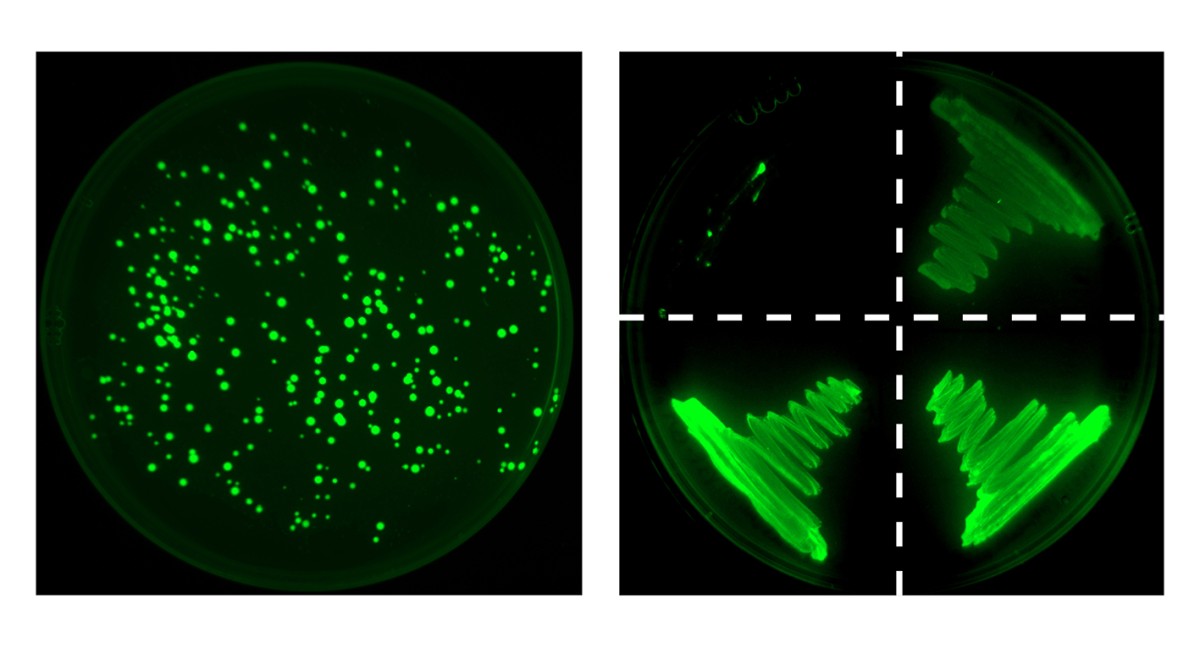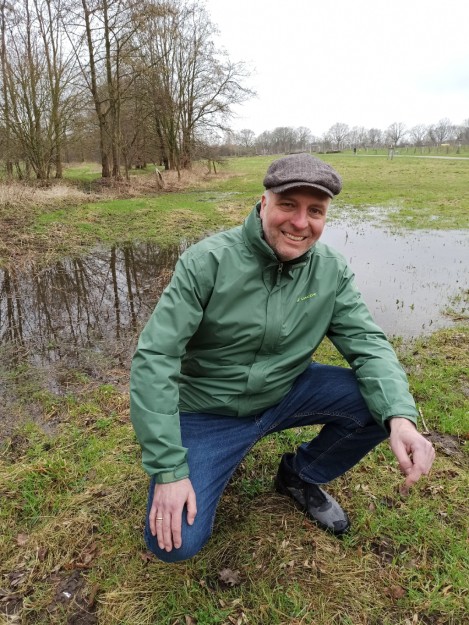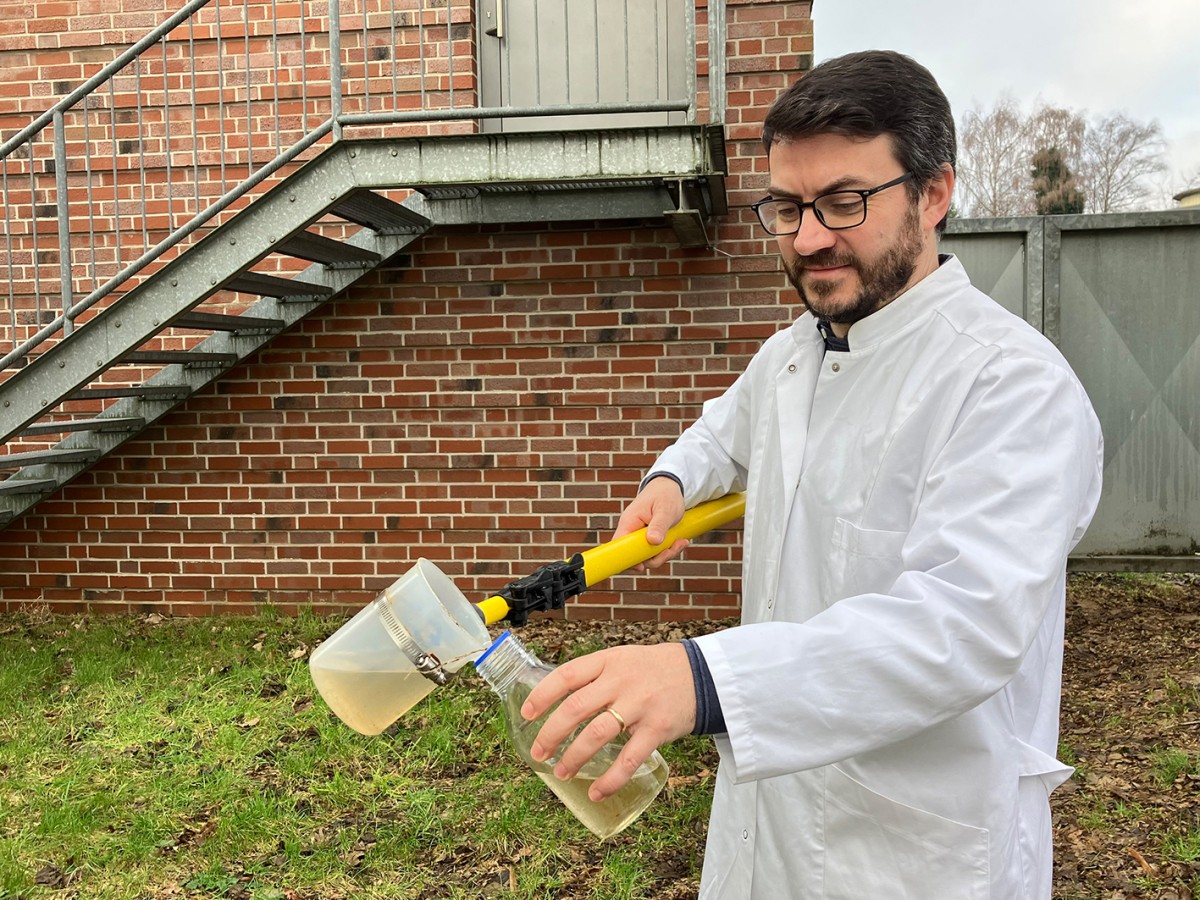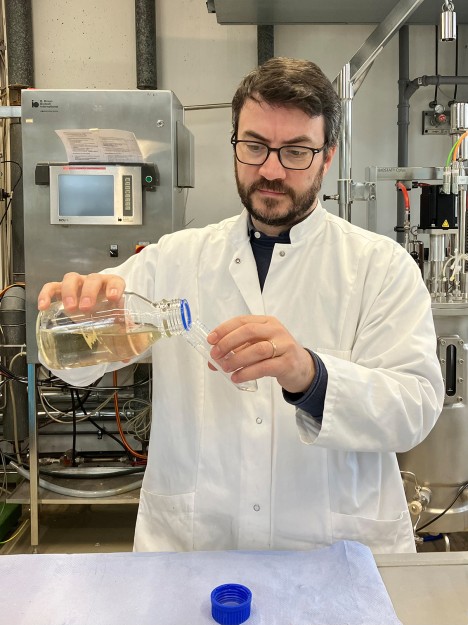
“Ways of decomposing chemicals may be developed in just a few decades’ time”
A team headed by Prof. Bodo Philipp and Dr. Johannes Holert from the Institute of Molecular Microbiology and Biotechnology has found bacteria in Münster’s wastewater which can completely decompose a substance called “TRIS” (tris hydroxymethyl aminomethane), and the researchers were able to throw light on the metabolic pathway. Among other things, TRIS is used to stabilise a pH value and often ends up in wastewater; it is very frequently used and is considered to be harmless. From an evolutionary standpoint, the TRIS metabolic pathway is new – a few decades old, at most, the researchers suspect. In this interview with Christina Hoppenbrock, Bodo Philipp explains what role new microbial metabolic pathways can play in treating wastewater, and why wastewater treatment plants are a good place to carry out research on the evolution of bacteria.
What is so fascinating about the micro-organisms you’re researching into?
There are thousands of pesticides, herbicides, medicinal drugs and other chemicals which humans manufacture. A large proportion of them find their way into the environment via wastewater. Some of these substances – which are predominantly based on carbon and are thus organic – are decomposed through existing biological metabolic pathways. Other substances accumulate because there are no mechanisms for decomposing them. This can be problematic – think, for example, of the widespread group of perfluorinated and polyfluorinated chemicals which are extremely long-lasting and which can harm living organisms. Some of these organic trace substances, for example, are suspected of having a negative impact on human procreation. Over the past decades, though, teams of researchers all over the world have discovered more and more decomposition pathways for persistent organic chemicals – in bacteria and in other micro-organisms. This indicates that decomposition pathways can develop within just a few decades in the community of micro-organisms after the first contact with such chemicals.
And a treatment plant is a good place to study this evolution?
It certainly is. It’s naturally teeming with micro-organisms which are all competing for lots of different organic substances – from easily decomposable faeces to those trace substances which are difficult, or even impossible, to decompose. Bacteria which succeed in using hitherto non-decomposable substances as nutrition can escape the process of competition – or can still grow when the faeces have been decomposed. In other words, in treatment plants there is pressure of natural selection which could favour the evolution of new metabolic pathways.
It was chance that led you to this discovery: what happened?
The fourth treatment stage is a current topic in Germany, and the aim it has is to filter out organic trace substances in treatment plants. Many plants have already been, or are being, upgraded. One question is the extent to which bacteria can be systematically used to decompose such trace substances. In our group we’re interested in bacteria which decompose the steroid hormones frequently found in wastewater. In the lab we noticed that some of the bacteria we collected in the treatment plant in Münster-Coerde grew in a pure TRIS buffer and didn’t need any further nutrition. That’s not something we had expected. TRIS is a component in the culture medium which ensures that the pH value remains stable.
What marks out the metabolic pathway you found?
TRIS is decomposed completely and enables the bacteria to grow. The pathway consists of two genetic components which presumably originated in metabolic pathways which were initially independent of each other, and which evolution brought together. One of the components is probably quite old and, in some bacteria, part of the metabolic pathway for the decomposition of unusual amino acids. The other component appears to have emerged only quite recently, as a result of mutation and natural selection. Only both modules together make TRIS decomposition possible. What’s interesting is that the genes involved only become active when TRIS is actually present. In other words, there is a regulatory mechanism – and that indicates that a complex evolutionary process took place. The genes for TRIS decomposition are not located in the bacterial chromosome – i.e. in the central genetic material – but within plasmids typical of the bacteria …
… if the bacterial chromosome is a manual with assembly instructions, plasmids are something like flyers which augment the blueprint.
Exactly. The DNA in the plasmid can multiply independently of the chromosomal DNA. And what’s ingenious is that the bacteria exchange the plasmids with one another through so-called horizontal gene transfer – across species boundaries. We originally discovered the TRIS decomposition in bacteria of the species Pseudomonas in samples from the Coerde plant, and later also in other wastewater samples from Münster and Hamm – in Pseudomonas, but also in the Shinella species of bacteria. We demonstrated in the lab that the Pseudomonas bacteria which we had isolated transfer the TRIS decomposition to another strain of Pseudomonas.
Do you have any theory about how long this metabolic pathway has existed and how it has been proliferating?
TRIS has been on the market for about 70 years now. We estimate that TRIS decomposition started around 50 years ago, at the most – possibly in the wastewater from a large research laboratory or a hospital, where, unlike in treatment plants, TRIS occurs in high concentrations. Via such wastewater, the TRIS-decomposing bacteria might have got into the treatment plants, where they proliferated. We also found the genes for TRIS decomposition in databases; they come from bacteria which were isolated in Korea and China. We don’t know, though, whether these bacteria can also decompose TRIS. Nor do we know whether the metabolic pathway emerged more than once. Micro-organisms can be distributed through passenger and freight transport and the plasmids can be transferred easily. In other words, TRIS decomposition could have proliferated worldwide from one place of origin.
The ability to decompose chemicals which can’t be filtered out of wastewater is good news – even if, as in this case, it isn’t a problematic substance. The evolution of micro-organisms is often talked about as a menacing scenario, for example in connection with antimicrobial resistances …
That’s the other side of the coin. Antibiotics also exist in wastewater, and so the bacteria there are also subject to the pressure of natural selection to acquire resistance genes. These genes have long been in existence. They are passed on among the bacteria by horizontal gene transfer, just like the ability to decompose TRIS, and they find their way into the environment. The proliferation of antimicrobial resistances is a serious problem.
Another problem is that of plastic finding its way into the environment.
So far there have hardly been any bacteria which can decompose plastic. However, I’m assuming that there will be more over the coming decades. But here, too, there will be a downside: in moist conditions, such bacteria can also nibble where they shouldn’t. I’m thinking for example of plastic insulation around underground cables.
Might it be possible to lend evolution a helping hand and “customise” bacteria to get waste out of the water?
What we have observed could also have been achieved genetically – but only with a lot of time and effort. However, it’s not allowed to discharge genetically modified organisms into the environment. What we can do, though, is expose micro-organisms to a high degree of natural selection with the aim, similar to plant cultivation, of selecting the ones which have emerged under these conditions by natural evolutionary processes.
The Philipp working group
Prof. Bodo Philipp and his team are investigating micro-organisms in natural and monitored waters in the region. The Münsterland is a model region well-suited to this research. On the one hand, there are the urban spaces; on the other, agriculture and industry. This enables the researchers to record the impacts which the various local factors have on the various waters. In future projects, the group aims to link up with important current issues such as how to handle water as a resource against a background of climate change, and what role micro-organisms might play in water management. The team is a member of of the interdisciplinary water network “Netzwerk Wasser” and it is also part of the Centre for Interdisciplinary Sustainability Research (Zentrum für interdisziplinäre Nachhaltigkeitsforschung, ZIN) at the University of Münster. The team also collaborates with the Fraunhofer Institute of Molecular Biology and Applied Ecology (Fraunhofer-Institut für Molekularbiologie und Angewandte Oekologie, IME) in Schmallenberg.
Original publication
Johannes Holert, Aron Borker, Laura Lucia Nübel, Rolf Daniel, Anja Poehlein, Bodo Philipp (2024): Bacteria use a catabolic patchwork pathway of apparently recent origin for degradation of the synthetic buffer compound TRIS, The ISME Journal, Volume 18, Issue 1, wrad023; DOI: 10.1093/ismejo/wrad023



